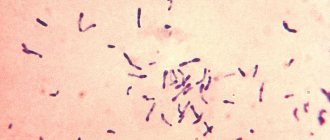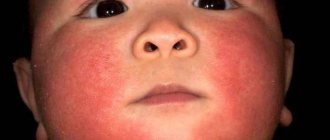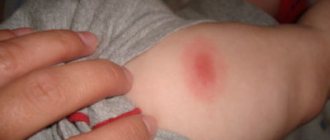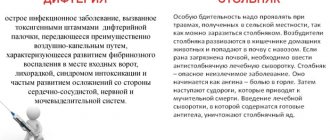Diphtheria
Diphtheria is a bacterial infection characterized by specific changes in the oropharynx and a pronounced toxic syndrome. Diphtheria is transmitted by airborne droplets (from a patient or a carrier during breathing), less often by contact (from contaminated objects). Infection occurs approximately 2-10 days from the moment of contact.
Diphtheria is characterized by pronounced changes in the oropharynx. The throat turns red, then becomes covered with a dense fibrin film, which is difficult to separate from the mucous membranes, and sometimes makes breathing difficult. Diphtheria of the larynx is accompanied by hoarseness and loss of voice, difficulty breathing, and in some cases bleeding.
The diphtheria bacillus is an infectious agent that can produce a toxin. Under its influence, a toxic syndrome develops in the body - swelling of the upper respiratory tract and subcutaneous fat. At the same time, patients feel clearly unwell: high fever, difficulty breathing, headaches. In addition, the disease is often complicated by myocarditis and pathology of the nervous system (encephalitis). To treat diphtheria, antibiotics are used, as well as antitoxic serum or immunoglobulin.
Diphtheria is now rare. It's not very contagious. But this disease is serious, and in the pre-vaccination era it was in first place as the cause of child mortality.
Whooping cough
Whooping cough is an infectious disease transmitted by airborne droplets. It manifests itself as a prolonged, intense, obsessive cough. The incubation period for whooping cough lasts from 1 to 2 weeks. After the disease develops, the patient can be a source of infection for up to a month. In addition, asymptomatic carriage is possible.
In children under one year of age, whooping cough infection often leads to attacks of respiratory arrest. And against this background, complications develop from the nervous and cardiovascular systems. In older children, the disease begins with the symptoms of a common cold: fever, runny nose, cough, redness of the throat. Then a long, painful paroxysmal cough develops. Attacks are sometimes accompanied by vomiting, hemorrhages in the skin of the face and conjunctiva, saliva and lacrimation, and swelling of the veins of the neck. This cough can last up to six months.
Antibacterial drugs are used to treat whooping cough. However, they can be effective only in the initial period, when whooping cough is almost impossible to distinguish from other acute respiratory viral infections. During the period of paroxysmal cough, antibiotic therapy is not effective. Treatment is carried out symptomatically and has virtually no effect on the duration of the cough.
Whooping cough is extremely contagious. It affects up to 95% of unvaccinated contacts. Even now, against the backdrop of universal vaccination, cases of whooping cough are not uncommon. The disease is especially dangerous in children who have not yet had time to get vaccinated for some reason.
Tetanus
Tetanus is a severe bacterial infection with a contact transmission mechanism, which is characterized by damage to the nervous system with the development of convulsions and tonic muscle tension. The infection is transmitted by contact. The microbe is widespread in nature, especially in agricultural areas. It is found in soil, water, and house dust. Often it is an inhabitant of the intestines of animals, sometimes humans. Tetanus bacillus can form spores that are resistant to high and low temperatures and antiseptic solutions.
The tetanus bacillus acquires its pathogenic properties in the absence of oxygen (anaerobic environment). Getting into the wound from contaminated surfaces, the microbe begins to multiply and release a toxin. The toxin enters the nervous system through the blood. The clinical picture is developing. From infection to the first symptoms it takes approximately 1 to 3 weeks. Initially, the muscles of the face and head are affected - a sharp muscle spasm occurs. Then the changes spread to the trunk and limbs, and convulsions appear. Muscle contractions can be so intense that they injure joints and ligaments. Damage to the muscles of the heart and respiratory tract is common.
In modern conditions, the patient dies from tetanus in approximately 20% of cases. The infection is especially dangerous in children of the first year of life. Mortality reaches 90-95%. Timely treatment can reduce mortality and reduce the manifestations of the disease. However, even with its use, recovery occurs only after 2-4 months; some consequences remain irreversible for the nervous system.
Tetanus is a very dangerous infection. It is still not uncommon to encounter tetanus bacillus spores in nature.
What vaccinations are there for whooping cough, diphtheria and tetanus?
- DTP is the most widely used vaccine in our country. It includes toxoid (neutralized toxin) of tetanus and diphtheria, as well as killed pertussis bacteria. In addition to the main components, the vaccine includes adjuvants, antiseptics and preservatives, as well as the main medium - a diluent.
- ADS and ADS-M are vaccines without a pertussis component. The ADS-M vaccine contains a reduced amount of diphtheria toxoid. These vaccines are used for revaccination in children after 7 years of age and in adults when whooping cough vaccination is no longer indicated.
- “Bubo-Kok” - in addition to the DTP components, this vaccine contains part of the hepatitis B viral protein. This is done in order to avoid giving the baby two injections at the same time, because Vaccinations according to the calendar are done together.
- "Bubo-M" is a vaccine without a pertussis component.
- "Pentaxim" - contains tetanus, diphtheria and pertussis toxoids, particles of the pertussis microbe. Additionally, polio has been added to this vaccine for ease of use. According to the vaccination calendar, the DTP and polio vaccination schedules coincide. A component against Haemophilus influenzae can be added to this vaccine from a separate vial. The decision about the need to administer it is made by the doctor. The vaccine is distinguished by the absence of whole pertussis cells - this causes fewer side effects.
- "Infanrix" is identical in composition to "Pentaxim", with the exception of the polio component - it is absent in it.
- "Infanrix hexa" - in addition to the components of "Infanrix", includes inactivated polio viruses and part of the hepatitis B virus protein.
- "Adasel" - includes: diphtheria, tetanus, pertussis toxoids and fragments of pertussis bacteria.
Pentaxim or DTP?
As for Pentaxim. The first difference from DPT is that Pentaxim also contains additional components against polio and hemophilus influenzae. These components are very important and are included in the national vaccination calendar.
Due to the fact that Pentaxim contains five components at once, the child will not have to take many injections, as with DTP. In my opinion, the unconditional advantage of Pentaxim is the reduction in the number of injections.
The second important difference: the component of the whooping cough vaccine is fundamentally different. In Russian, these are parts of cells, large compounds containing many antigens. Because of this, unpleasant reactions to DPT quite often occur.
As part of Pentaquim, whooping cough is split, the shell is removed from it, so it is, as a rule, better tolerated by the baby. Usually it is the shell that gives the negative effect. The immune system does not develop protection as aggressively as in the case of a cellular vaccine (DTP).
However, Pentaxim also has disadvantages. Although many parents perceive this moment as an absolute plus: children are much less likely to have a temperature on Pentaxim.
Why is this a minus? Due to the fact that the immune system does not work so aggressively, there is not a large number of pertussis antigens, the immune memory produced is not as long-term as with domestic vaccination. In older preschool and school age, children can suffer whooping cough in almost the same way as unvaccinated children.
Another disadvantage of Pentaxim is its cost. It must be admitted that not all families can afford paid vaccines. Fortunately, in some regions of the country there is a practice of purchasing Pentaxim, and not DPT, for vaccination, in which case the vaccination will be free.
When is DTP vaccination given?
According to the national calendar, DPT vaccination is given at 3 months, 4.5 months and 6 months. Revaccination is done at 18 months. The second revaccination at 6-7 years is carried out without the pertussis component. The third - at the age of 14, and then every 10 years - also without adding the whooping cough component.
What to do if the DPT vaccination was not done on time?
If vaccinations are not completed, the calendar is continued at the same intervals indicated in the calendar. The second vaccine is given no less than 1.5 months after the first. The third is no less than 1.5 months from the second. Revaccination at least 12 months after the last vaccination.
DTP vaccination is given up to 4 years of age. After 4 doses, DTaP is given (in this case, the interval between the third vaccination and revaccination can be reduced to 6 months).
"Infanrix hexa", according to the instructions, is only done up to 36 months.
"Infanrix" and "Pentaxim" can be done up to 6 years.
"Adasel" is used only for revaccination at 6-7 years of age and for vaccination in adults every 10 years.
Children over 6 years of age are vaccinated only with pertussis-free vaccines (ADS, ADS-M, Bubo-M) or the Adasel vaccine. They receive two vaccinations 1.5 - 2 months apart. Revaccination after 9-12 months. And the second revaccination after 2 years.
How are vaccines different?
Many people believe that Pentaxim is DPT because they are prescribed for vaccination.
But the latter option protects against the following diseases:
- Whooping cough. This is a respiratory tract infection accompanied by a characteristic cough. It is dangerous due to complications such as pleurisy, bronchitis, pneumonia.
- Tetanus. An infectious disease that affects the nervous system, is accompanied by severe convulsions and can be fatal.
- Diphtheria. The disease, which occurs in a severe form, is accompanied by inflammatory processes in the nasopharynx, causing complications on the central nervous system and cardiovascular system.
All 3 diseases are difficult to tolerate even by adults, and in children they can cause dangerous complications even with a favorable outcome. Before the advent of vaccines, such pathologies were considered the most common causes of child mortality. But Pentaxim protects not only from these diseases, but also from 2 more pathologies:
- polio;
- hemophilus infection.
The compositions of the drugs vary. DPT contains some pertussis microbial cells, diphtheria toxoid flocculating units and tetanus toxoid antitoxin binding units.
Pentaxim is produced using a completely different technology.
In addition to diphtheria, tetanus and pertussis toxoid, it contains inactivated polio viruses types 1, 2 and 3, filamentous hemagglutinin.
An analogue of Pentaxim is Infanrix. Both vaccines have earned a good reputation among doctors, while after DPT, adverse reactions and complications often develop.
In addition to pharmacological properties and composition, they have another important difference. The DTP vaccine is produced in Russia and is administered free of charge in accordance with the national vaccination calendar. The Pentaxim vaccine is produced in France, and parents will have to buy it themselves.
Vaccination schedule
The vaccination schedule does not depend on the type of vaccine as such. Pentaxim is administered for the first time before the child reaches 6 months of age. The DPT vaccination is given for the first time at 3 months, then repeated at 6 months, and then revaccination is carried out later.
When using Pentaxim, another 2 and 3 doses are administered with a break of not 3, but 1.5 months between each vaccination. And after reaching the age of 12 months, the first revaccination is carried out.
Adverse reactions
The main difference between Pentaxim and DPT is not in the adverse reactions, but in the list of diseases that it is designed to fight. Side effects include:
- Local soreness in the area where the injection was made, induration and redness appear there. This reaction appears 48 hours after administration of the drug, the child cries.
- Increased body temperature.
- Drowsiness or sleep disturbance, irritability, prolonged crying.
- Diarrhea or vomiting.
- Allergic manifestations.
Pentaxim is also distinguished by the fact that an increase in temperature during its administration occurs less frequently than when using DTP. For the latter, adverse reactions will be more pronounced, but similar.
Contraindications
There are also differences in contraindications for vaccines.
For Pentaxim:
What do you think are the most important factors when choosing a medical institution?
- encephalopathy, including those accompanying seizures;
- severe adverse reactions after previous vaccination;
- allergic manifestations, including those that occurred between the first and subsequent administration of the vaccine;
- the presence of hypersensitivity to its components;
- infectious and inflammatory diseases in which body temperature rises.
DPT also has a number of contraindications: progressive diseases of the nervous system, the presence of low-grade seizures. The difference in contraindications between vaccines is explained by the way they are produced.
What complications can occur after DPT vaccination?
DTP is one of the most reactogenic vaccinations in the calendar. Should we be afraid of it and refuse it?
Indeed, after the administration of DTP, adverse reactions often occur:
- An increase in body temperature to 38.5*C occurs in approximately half of the cases after injection of the DPT vaccine. When using acellular vaccines (Prevenar, Infanrix or Adasel), it occurs approximately 2-3 times less often. Less common is an increase in temperature to 39*C (about 10% of cases). Extremely rare - up to 40*C (less than 0.5% of all vaccinated people). This increase in temperature goes away 1-3 days after vaccination on its own and only requires the use of an antipyretic drug in an age-appropriate dose to improve the child’s well-being.
- Irritability and prolonged crying. Also quite common. For DPT, approximately 40% of all vaccinations. For acellular vaccines, this percentage drops to about 15%. It goes away on its own in 1-2 days. Requires only observation and care of the baby.
- Local reactions in the form of swelling, redness and pain at the injection site occur with varying intensity in approximately half of those vaccinated. Local reactions are observed much less frequently in those vaccinated with acellular vaccine. Pain in the first days after vaccination can be reduced with the help of the same medications that are used to bring down a high fever. If redness, swelling and pain increase, and the drugs turn out to be ineffective, it makes sense to show the baby to the doctor in order not to miss complications associated with infection of the injection site, or violation of the drug administration technique.
- Sometimes, for several days after vaccination, the baby is worried about loss of appetite and, as a result, weight loss. This phenomenon is temporary and does not require correction.
- Vomiting occurs in approximately 15% of vaccinated children. It is never painful, repeated or long lasting. Does not require treatment. But you should notify your doctor about such a reaction.
- Rarely (approximately 0.02% for DTP and even lower for acellular vaccines) febrile seizures occur in children after vaccination. Such convulsions occur at elevated temperatures. More often, children have a congenital predisposition to the development of such seizures. Vaccination in such situations serves only as a provoking factor. In most cases, febrile seizures are not dangerous for the baby, although they are very frightening for parents. After a seizure, a child must be seen by a doctor. And warn your doctor about previous cases of such an adverse reaction.
Severe and rare complications after vaccination include:
- Acute allergic reactions. Immediately after vaccination, mother and baby are recommended to spend about half an hour within the walls of a medical institution.
- Hypotensive-hyporesponsive syndrome. The risk is present approximately in the first 12 hours after vaccination. The child suddenly turns pale, becomes lethargic and lethargic. This complication does not require treatment, it goes away on its own, but it requires medical supervision. Hypotensive-hyporesponsive syndrome after DPT vaccination raises the question of further vaccination.
To reduce the risk of severe adverse reactions, examination before vaccination is recommended. Before vaccination, the child should not be sick with an acute respiratory infection. Chronic diseases must be in remission. If necessary, the attending physician can prescribe treatment for a child with a chronic disease during vaccination.
It must be said that the subsequent vaccination is more difficult to tolerate than the previous one. In children with severe reactions, it is advisable to replace the vaccine with an acellular one or one that does not contain the pertussis component.
Are there different contraindications?
Both vaccines, intended for intramuscular administration, contain neutralized infections and therefore can cause allergic reactions and complications. This explains the similarities in contraindications. The use of Pentaxim is indicated for pediatric patients for primary vaccination and revaccination. The drug is contraindicated for:
- encephalopathy (with and without convulsive syndromes);
- strong reaction after primary immunization (develops within two days);
- hypersensitivity to components;
- elevated body temperature as a consequence of illness (transferred for a period of two to four weeks from the moment the temperature normalizes).
DPT vaccination is not carried out if:
- any diseases of the nervous system (exacerbation);
- pathologies of the nervous system at the progression stage;
- presence of a strong allergic reaction;
- immunodeficiency;
- convulsions without fever;
- acute respiratory diseases (immunization is postponed for a period of two to four weeks from the moment of complete normalization of the condition);
- severe reaction during the first vaccination (temperature - 40 degrees and above, crying for more than three hours, convulsions).
Failure to comply with contraindications can lead to serious complications in the form of disorders of the nervous system, therefore, before vaccination, the child should be examined by a pediatrician. After vaccination, monitoring of the baby's condition is required.
If severe reactions are recorded (increased body temperature, crying for more than three hours, convulsions), you should seek medical help.











